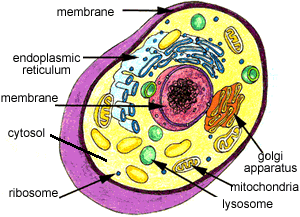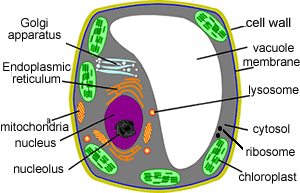Plant and animal cells have many similarities. They contain many similar organelles, such as the nucleus, mitochondria , membrane and ribosomes just to name a few. Each organelle performs specific functions which enable the cell to function in a unique way.
Click for a detailed explanation of each organelle.

Some very important differences exist however. Plant cells differ from animal cells in that they contain chloroplasts. These are membrane bound organelles that contain chlorophyll and produce sugars through a process called photosynthesis. The process is outlined below.
CO2(g) + H2O(g) + solar energy => sugar + O2(g)
Another very important feature that is unique to plant cells is the cell wall. This is a sturdy structure made of cellulose that helps maintain the shape of the cell.
Vacuoles are fluid filled vesicles that are larger in plant cells than in animal cells and help maintain water pressure within the cell.
